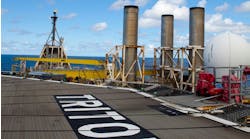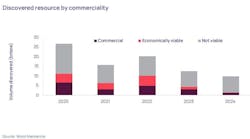NORWAY: Shell aiming for 75% recovery from Draugen through lateral thinking, 4D seismic
Norske Shell aims to squeeze the maximum possible from its prize asset, the Draugen field in the Norwegian Sea. It has set itself the tough stretch target of achieving a 75% rate of recovery, a move that would probably extend the field's producing life to close to 2020.
Since Draugen came into production in 1993, the first field development in the Norwegian Sea, Shell has undertaken several initiatives to boost both production and recovery, including de-bottlenecking facilities to raise production capacity, the introduction of gas exports, development of the Garn West and Rogn South structures, and the introduction of gas-lift. Oil production capacity now stands at 225,000 b/d, though output has at times exceeded this level. In 2001, oil production averaged 204,000 b/d.
Operations on Norske Shell's Draugen platform could be extended to around 2020 if the company achieves its goal of 75% recovery.
Norske Shell was itself given a lift earlier this year when it purchased the 10% stake in the field that was previously part of the State's Direct Financial Interest portfolio. This raised the company's overall holding in the field to 26.2%.
The expected rate of recovery will be 66%, well above the current 44% rate for Norwegian fields and the 50% goal set for the sector by the Nor-wegian Petroleum Directorate. According to the NPD, Draugen's total recoverable reserves are 932.2 MMboe, comprising 861.7 MMbbl of oil, 7.4 bcm of gas, and 2 million tons of NGLs. At end-2001, 47.5% had been produced.
New technology
The goal of 75% recovery is a stretch target incorporating the application of new technology, Norske Shell says. Two main tools are being used as the basis for identifying how this target can be achieved:
- A program called Volumes to Value (V2V), the main objective of which is to identify new projects to increase production and the recovery rate
- The use of 4D seismic to plot the movement of fluids in the reservoir and detect areas of unswept oil.
At V2V workshops, petroleum engineering experts discuss all aspects of the identification of oil volumes and how to maximize reservoir production. It is in essence a "technical limit" process, whereby the total volume of oil originally in place is broken down into local units. Attention is then concentrated on each unit to identify the fundamental physical reasons why it may or may not be possible to recover that unit.
The next stage is a brainstorming exercise to find any possible way of achieving production, including the use of new technologies, regardless of cost or practicality. When a total list of opportunities has been drawn up, it will be subjected to cost estimation and risk assessment to identify the opportunities worth pursuing. There is no strict deadline for the program, though Norske Shell points out that the earlier opportunities and strategies can be identified, developed, and pursued, the higher the value of the additional recovered volumes will be.
The use of 4D seismic has proved a valuable reservoir management tool and has a central part to play in future plans at Draugen. Following a base survey in 1990, two monitor surveys have been carried out, in 1998 and 2001.
In the next survey, high resolution data will be acquired, with the intention of using a subset of the data as an additional 4D monitoring survey. The use of high frequency seismic as a reservoir imaging tool permits the identification of potential production opportunities that have been bypassed, the company says. Attic oil may have remained in small local structural highs, often bounded by faults of little throw, with an order of magnitude of just a few meters. Having identified these pockets, the next challenge is to find ways of developing them economically through the V2V process.
Water production
By means of 4D seismic technology, Norske Shell has established that the water front is moving somewhat faster than was originally thought likely, a finding that has been confirmed by recent water production data. The record-breaking A4 well, which flowed in excess of 76,000 b/d when it came onstream, has recently suffered water breakthrough and is temporarily shut-in due to scale formation downhole.
Nevertheless, water production is still at a modest level, less than 9,500 b/d. It was expected from the beginning, and preparations to meet it have been in hand for some time. Water-handling capacity has been increased, gas-lift is being commissioned, and a scale management team is tackling the problems of scale deposition in the wells.
Water injection has been in use on Draugen since the early days. Water is injected into the south and north of the 20-km-long field, sweeping the hydrocarbon towards the production wells in the central part. Currently, a volume of some 260,000 b/d is being injected. This volume is not due to be increased, but plans are in hand to optimize the location of injection. Water-alternating-gas injection is also being evaluated.
The current NKr 1.7 billion investment program culminates in 4Q 2002, when gas-lift operations will start in all but one of the oil-producers and Rogn South will come onstream. Rogn South, which lies in the south of the field, is being developed with two subsea wells that are due to be tied back 10 km to the platform by flexible pipelines to be laid by Coflexip Stena Offshore in August. Garn West, which lies west of the platform and came onstream in November 2001, was also developed with two subsea wells.
Further infill drilling is a possibility, but will only be considered when the full field reservoir model that is currently being updated becomes available.




